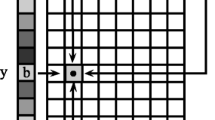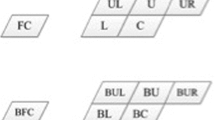Abstract
In this paper, we propose an implicit line-based linear intra 16×16 prediction method for high-quality video coding. Typically, in H.264/AVC intra 16×16 vertical and horizontal prediction modes, 256 pixels in the current macroblock are predicted using 16 adjacent boundary pixels of reconstructed neighboring macroblocks. One problem of such a block-based intra prediction is that the prediction error increases as the distance between the reference and current pixels increases. Thus, the prediction accuracy of intra 16×16 vertical and horizontal modes is not sufficient for the mode decision stage. To ensure that the pixels are close to their predictor, we propose a new implicit intra prediction scheme, which makes full use of the correlation between lines instead of blocks. In the proposed method, we perform prediction, transformation, quantization, and reconstruction using the line-of-pixels (LOP) to improve the prediction accuracy. Experimental results show that the proposed algorithm provides an approximately 6.42 % bit-rate reduction compared to the H.264/AVC FRExt high profile, while maintaining the same decoding quality.













Similar content being viewed by others
References
G. Bjøntegaard, Improvements of the BD-PSNR model. ITU-T Q.6/SG16 Video Coding Experts Group Document VCEG-AI11, 2008
D. Brunello, G. Calvagno, G. Mian, R. Rinaldo, Lossless compression of video using temporal information. IEEE Trans. Image Process. 12(2), 132–139 (2003)
J. Chen, W.-J. Han, Adaptive linear prediction for block-based lossy image coding, in Proc. of International Conference on Image Processing (2009), pp. 2833–2836
J.-A. Choi, Y.-S. Ho, Line-by-line intra 16×16 prediction for high quality video coding, in Proc. of IEEE International Conference on Multimedia & Expo (ICME) (2010), pp. 1281–1286
Y. Guo, Y. Wang, Q. Li, Priority-based template matching intra prediction, in Proc. of International Conference on Multimedia and Expo (2008), pp. 1117–1120
H.264/AVC Reference Software Version 12.2. http://iphome.hhi.de/suehring/tml/download/old_jm/jm12.2.zip
A. Luthra, G. Sullivan, T. Wiegand, Introduction to the special issue on the H.264/AVC video coding standard. IEEE Trans. Circuits Syst. Video Technol. 13(7), 557–559 (2003)
S. Matsuo, S. Takamura, K. Kamikura, Y. Yashima, Weighted intra prediction. ITU-T Q.6/SG16 Video Coding Experts Group Document VCEG-AG18, 2007
K. McCann, W. Han, I. Kim, Samsung’s response to the call for proposals on video compression technology. ISO/IEC JTC1/SC29/WG11 and ITU-T Q.6/SG16 Joint Collaborative Team on Video Coding Document JCTVC-A124, 2010
X. Peng, J. Xu, F. Wu, Line-based image coding using adaptive prediction filters, in Proc. of International Symposium on Circuits and Systems (2010)
Y. Sohn, W.-J. Han, One dimensional transform for H.264-based intra coding, in Proc. of Picture Coding Symposium (2007)
G. Sullivan, T. Wiegand, Video compression–from concepts to the H.264/AVC standard. Proc. IEEE 1, 18–31 (2005)
G. Sullivan, T. McMahon, T. Wiegand, A. Luthra, Draft text of H.264/AVC Fidelity Range Extensions Amendment to ITU-T Rec. H.264 | ISO/IEC 14496-10 AVC. ISO/IEC JTC1/SC29/WG11 and ITU-T Q6/SG16 Joint Video Team Document JVT-L047, 2004
G. Sullivan, P. Topiwala, A. Luthra, The H.264/AVC advanced video coding standard: overview and introduction to the Fidelity Range Extensions, in SPIE Conference, Special Session on Advances in the New Emerging Standard: H.264/AVC (2004), pp. 454–474
T. Tan, C. Boon, Y. Suzuki, Intra prediction by template matching, in Proc. of International Conference on Image Processing (2006), pp. 1693–1696
T. Tan, C. Boon, Y. Suzuki, Intra prediction by averaged template matching predictors, in Proc. of Consumer Communications and Networking Conference (2007), pp. 405–409
K. Ugur, K. Andersson, A. Fuldseth, Description of video coding technology proposal by Tandberg, Nokia, Ericsson. ISO/IEC JTC1/SC29/WG11 and ITU-T Q.6/SG16 Joint Collaborative Team on Video Coding Document JCTVC-A119, 2010
L. Wei, M. Levoy, Fast texture synthesis using tree-structured vector quantization, in Proc. of SIGGRAPH (2000), pp. 479–488
T. Wiegand, G. Sullivan, G. Bjøntegaard, A. Luthra, Overview of the H.264/AVC video coding standard. IEEE Trans. Circuits Syst. Video Technol. 13(7), 560–576 (2003)
S. Yu, C. Chrysafis, New intra prediction using intra-macroblock motion compensation. ISO/IEC JTC1/SC29/WG11 and ITU-T Q.6/SG16 Joint Video Team Document JVT-C151, 2002
Y. Zheng, P. Yin, O. Escoda, X. Li, C. Gomila, Intra prediction using template matching with adaptive illumination compensation, in Proc. of International Conference on Image Processing (2008), pp. 125–128
Acknowledgements
This work was supported by the Basic Research Project through a grant provided by GIST.
Author information
Authors and Affiliations
Corresponding author
Rights and permissions
About this article
Cite this article
Choi, JA., Ho, YS. Implicit Line-Based Intra 16×16 Prediction for H.264/AVC High-Quality Video Coding. Circuits Syst Signal Process 31, 1829–1845 (2012). https://doi.org/10.1007/s00034-012-9405-2
Received:
Revised:
Published:
Issue Date:
DOI: https://doi.org/10.1007/s00034-012-9405-2




